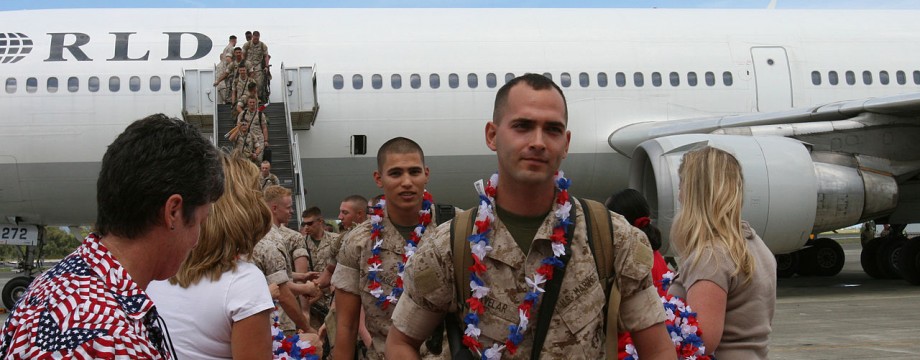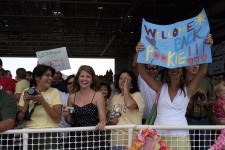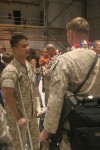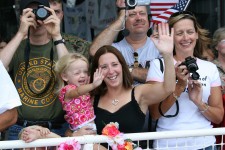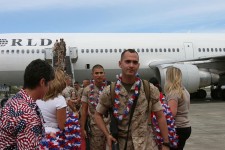 “The Battalion Main Body redeployed to the Marine Corps Base Hawaii from Kuwait.” Source — 3/3 Command Chronology for the Period 01 October to 31 December 2006
“The Battalion Main Body redeployed to the Marine Corps Base Hawaii from Kuwait.” Source — 3/3 Command Chronology for the Period 01 October to 31 December 2006
Contents
3/3 Command Chronology
“During the first 5 days of October, the Battalion’s main body re-deployed from Kuwait to Marine Corps Base Hawaii and was greeted by the family and friends at Hanger 5. The Battalion quickly conducted a safety brief and ensured all Marines and gear were accounted for. Once this was accomplished the Battalion secured for a seventy-two hour liberty weekend.” Source: 3/3 Command Chronology for the Period 01 October to 31 December 2006
News
“America’s Battalion” wraps-up six month Iraq deployment, returns to base in Hawaii
Sgt. Roe F. Seigle | 1st Marine Division | October 06, 2006
Al-Asad Airbase, Iraq
The Battalion Main Body redeployed to the Marine Corps Base Hawaii from Kuwait.
Kuwait International Airport (KWI), Kuwait
The Battalion Main Body redeployed to the Marine Corps Base Hawaii from Kuwait.
Marine Corps Air Station Kaneohe Bay
The Battalion Main Body redeployed to the Marine Corps Base Hawaii from Kuwait.
The Haditha Triad Region consists of the three Euphrates River towns — Haditha, Barwanah and Haqlaniyah, and boasts a population of about 50,000.
Throughout their deployment, 3rd Battalion’s forces trained Iraqi Security Forces, located 54 weapons caches and detained more than 800 suspected insurgents, according to Master Sgt. Ronald Rice, 36, operations chief for 3rd Battalion. They also conducted more than 8,000 patrols.
The battalion also worked closely with Iraqi police and soldiers to provide security in Baghdadi, a small city of about 5,000, just 25 miles south of the Triad along the Euphrates.
The Marines were accompanied by Iraqi security forces on approximately one-third of the patrols, said Rice.
The battalion suffered 11 deaths during its deployment. Still, the Marines performed to par, and made a dramatic difference in Iraq, according to Lt. Col. Norman L. Cooling, 3rd Battalion’s commanding officer.
“The Marines’ enemies here do not follow the Geneva Convention and play by a different set of rules that Marines do not recognize,” said Cooling. “The enemy often does things that are shocking and repulsive to civilized people – like machine-gunning several unarmed police recruits to death earlier this summer.”
Cooling, a native of Baytown, Texas, said the battalion’s most valuable contribution to Iraq was the advancement of Iraqi Security Forces, to include Iraqi policemen and soldiers.
Upon arrival, the abilities of the Iraqi soldiers were limited to individual skills and were “very basic.” Now, the soldiers have motorized capabilities to react to situations and are conducting platoon, company and battalion-level operations independently and some Iraqi units are frequently assigned their own area of responsibility, said Cooling.
For 3rd Battalion’s final large-scale operation, dubbed Operation Guardian Tiger IV, only a handful of Marines accompanied Iraqi soldiers when they spread out through the Baghdadi Area to conduct a complete census of the city’s villages.
“The Marines did what they have always done in the past,” said Cooling, 42. “They came to a hostile area that was riddled with chaos and initiated the process of establishing security.”
Sgt. Rodrigue Jean Paul, 31, a platoon guide assigned to 3rd Battalion’s Lima Company, says the deployment was an “eye-opener” for him and his Marines.
Rodrigue was close friends with Cpl. Yull Estrada Rodriguez, a 21-year-old who was killed Sept. 20, 2006.
“You cannot describe the loss of one of your friends,” said Rodrigue, a native of Queens, N.Y. “It is a part of you that is lost and you can never get back. You just take what you have left and move forward but never, ever, forget those that you lost.”
For some Marines, they say that they no longer take things for granted that they once did – like a hot shower after being in 130-degree heat all day.
“Your feelings toward life itself changes out here,” said Lance Cpl. Timothy Trumbull, 21, a rifleman assigned to Lima Company. “I can’t even explain how good of a feeling it will be when I get home to see my family.”
Cooling, who also command the battalion during a six-month deployment to Afghanistan in 2005, said he is “exceptionally proud” of his Marines, their accomplishments and sacrifices.
“When the greatest threat of our generation came, the majority of Americans watched it on T.V.,” said Cooling. “Only a select few with a moral compass, selflessness and a strong set of values will volunteer to risk their lives to meet that threat.”
The Marines say their last mission will be their easiest one – getting on a plane and flying home to their families.
“It is time to make up for time lost,” said Trumbull.
Source: 1st Marine Division Press Release
America’s Battalion, Pegasus return to Hawaii
By Lance Cpl. Edward C. deBree | Marine Corps Base Hawaii | September 16, 2006
MARINE CORPS BASE HAWAII — As the afternoon of Sept. 15 slowly became evening, family members and Marines of 3rd Battalion, 3rd Marine Regiment were anxiously working to prepare Hangar 105 for the midnight return of America’s Battalion.
Friends and family members hung signs around the hangar that welcomed home the returning Marines and Sailors.
As setup for the homecoming was completed, family members and friends waited for the plane carrying their loved ones to land.
Among the crowd was a special group of Marines who were also waiting for the battalion’s return.
Some held themselves up with crutches, while others whose injuries were not openly visible also stood waiting for their fellow Marines to return.
The injured Marines had fought along side the returning Leathernecks and Sailors who were returning from Iraq where they had served in support of Operation Iraqi Freedom.
The obvious difference was that the injured 3/3 Marines had been sent home after sustaining injuries that left them unfit for battle.
“These Marines were hit by IEDs (improvised explosive device), RPGs (rocket-propelled grenades), and shot at,” said Gunnery Sgt. Jason Jerome, command family liaison officer. “My job is to handle any admin issues for the families, act as the liaison between the regiment and the battalion, and arrange for the families to come over here to visit their loved one if they are sent back from Iraq.”
As time for the plane’s arrival grew closer, the wounded Marines reflected on their tour of duty in Iraq.
Lance corporals Chaim Kozak and James L. Roebeck, mortarmen assigned to Weapons Company, sat and reminisced about the time they were together in Iraq. Both injured, Roebeck was sent back a few weeks before Kozak.
“I was hit by a roadside bomb that sent me flying over the turret during a patrol,” explained Roebeck, a Drummonds, Tenn. native. “I got what is called partial paralysis in my left leg and a shattered back.”
Kozak sustained a similar injury a few weeks later when a roadside bomb detonated and sent him flying out of his Humvee, over the turret.
“That was a really bad blast,” said the Westland, Mich. native. “It killed our driver and left me on the ground coughing up blood.”
In another area of the country, a fellow Marine assigned to Kilo Company was manning the turret of a seven-ton truck when an IED went off, flipping the truck over and causing the truck to land on him.
“We were doing mounted vehicle patrols and came up to this intersection where I proceeded to wave a flag to make sure all Iraqi vehicles stopped,” said Lance Cpl. Arden M. Wright, a squad automatic weapon gunner and Teaneck, N.J. native. “The IED went off and the seven-ton flipped, throwing me out of the turret, and landing on my leg, breaking it into seven pieces.”
Wright said that when he realized that he was airborne after the explosion, he “tucked and ducked” to brace for the landing.
After the vehicle flipped and landed on his leg, Wright heard shots being fired at the Marines by insurgents. Not wanting to get shot in his predicament, Wright forced his way from underneath the vehicle and limped away to a safer location.
“When all was said and done, the people on that patrol thought I was able to walk, because they saw me get up and take cover,” said Wright. “Then they looked at my leg and realized that it didn’t look right because it looked like my knee was facing the other way, so they MediVaced me out of there.”
While it’s a common occurrence for Marines on patrol to encounter IEDs, Lance Cpl. Jesse P. Stecklein, team leader, 3rd Platoon, Kilo Company, was hit by two while clearing a hotel to set up security for another squad.
When he headed up the stairs from the first floor to the second, two IEDs went off simultaneously, resulting in the Columbus, Ohio native receiving a dislocated shoulder, second-degree burns to the face, and shrapnel in his left hip, leg, and lower abdominal area.
Though Stecklein sustained multiple injuries, the real concern to him at the time of the explosions was whether or not his fellow Marine was safe.
“The first thing that went through my mind was whether or not my buddy was OK and not killed,” said the 21-year-old. “Another Marine grabbed me and carried us to safety and took care of us as the other Marines provided security.”
Though at times it can be hard for Marines to identify an IED, Cpl. Jesse Torres and his fellow Marines uncovered what they thought looked like one.
On their way back from the forward operating base in Haditha, Marines assigned to Jump Platoon, Weapons Company, spotted a blue bag on the side of the road that was not there before, so they got out to investigate.
Torres said they had the gunner look through binoculars to scan for wires coming from the bag. After confirming there were no wires, the Marines did an IED sweep up to the bag to get a closer look.
As the Marines approached the bag, Torres said his platoon commander, Staff Sgt. Jason C. Ramseyer, told him to stay back and he went to look for himself. The bag turned out to be a decoy for an IED that was buried in between rocks across the road.
“At first, when the blast went off, everything was in slow motion,” said the Long Beach, Calif. native. “When I first got hit, I didn’t feel a thing, but about five seconds later, the pain came rushing in. A lot of emotions went through my head at that moment. There was a lot of anger, anxiety, sadness … wondering who pulled the trigger … just a lot of mixed emotions. The only thing that I worried about when it went off was if my staff sergeant was alright.
“He saved my life. He was the one that told me to go back 10 to 15 feet. If he didn’t tell me that, I would have died,” continued Torres as his voice started to tremble. “I have never known a staff noncommissioned officer who motivated me so much. Whenever I saw him and talked to him, I wanted to be like him.”
Ramseyer is Torres’ hero. Other Marines attribute their survival to others during their encounters.
For Kozak it was Lance Cpl. Harry A. Joe who saved his life.
“When we were attacked, Joe was the first one to come help us and get the ‘Doc,’” said Kozak. “When they took me back to the FOB (forward operating base), he sat with me the whole time and took care of me.”
Roebeck attributes his survival to the hospital corpsman assigned to his unit. It was the ‘Doc’s’ quick response and dedication to making sure Roebeck was recovering properly.
“He stayed with me and took care of me up to the point where they finally put me on the helicopter to MediVaced me,” he said. “That was true dedication.”
“I’m happy they’re coming home,” said Stecklein. “I only wish that I was coming back with them.”
Kelbaugh echoed Stecklein’s words, saying he wished he were returning with his unit instead of welcoming them home.
“It just doesn’t feel fair that I’m here and they’re not,” he said. “They are the ones that saved my life, and I’m here and not with them.”
Source: Hawaii Marine
Photographs
- Chaim Kozak
